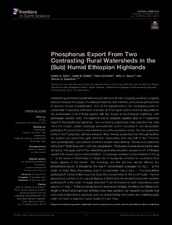| dc.contributor.other | Faculty of Civil and Water Resources Engineering, Bahir Dar Institute of Technology, Bahir Dar University, Bahir Dar, Ethiopia | |
| dc.contributor.other | International Water Management Institute, Yangon, Myanmar | |
| dc.contributor.other | Departments of Biological and Environmental Engineering, Cornell University, Ithaca, NY, United States | |
| dc.creator | Sishu1, F. K. | |
| dc.creator | Bekele, A. M. | |
| dc.creator | Schmitter, P. | |
| dc.creator | Tilahun, S. A. | |
| dc.creator | Steenhuis, T. S. | |
| dc.date.accessioned | 2022-06-17T18:59:20Z | |
| dc.date.available | 2022-06-17T18:59:20Z | |
| dc.date.issued | 2021 | |
| dc.identifier.citation | Sishu1, F. K.; Bekele, A. M.; Schmitter, P.; Tilahun, S. A.; Steenhuis, T. S. (2021). Phosphorus Export from Two Contrasting Rural Watersheds in the (Sub) Humid Ethiopian Highlands. Frontiers in Earth Science, 9, 762703. | en |
| dc.identifier.uri | https://hdl.handle.net/1969.1/196209 | |
| dc.description.abstract | Establishing worldwide sustainable and phosphorus efficient cropping systems is urgently needed because the supply of suitable phosphate rock is limited, and excess phosphorus in streams causes eutrophication. One of the impediments in the developing world for sustainable P practices is the lack of studies on P transport and its eventual disposition in the environment. One of these regions with few studies is the Ethiopian Highlands, with permeable volcanic soils. The objective was to establish baseline data on P watershed export in the (sub)humid highlands. Two contrasting watersheds were selected near Lake Tana. For 2 years, stream discharge and sediment, total P, dissolved P, and bioavailable particulate P concentrations were determined at the watershed outlet. The first watershed is the 57 km2 Dangishta, with lava intrusion dikes, forcing subsurface flow through faults to the surface and preventing gully formation. Subsurface flow was half of the 1745 mm annual precipitation, and surface runoff and erosion were minimal. The second watershed is the 9 km2 Robit Bata with 1,420 mm precipitation. The banks of several river banks were slumping. The upper part of the watershed generates saturation excess runoff. A hillslope aquifer in the lower part provided interflow. The average sediment concentrations of 10.5 g L−1 in the stream in Robit Bata (11 times that in Dangishta) reflected the sediments from banks slipping in the stream. The hydrology and the soil loss directly affected the phosphorus export. In Dangishta, the total P concentration averaged 0.5 mg L−1 at the outlet. In Robit Bata, the average total P concentration was 2 mg L−1. The bioavailable particulate P concentration was only twice the concentration in the runoff water. The low phosphorus content of the subsoil slipping in Robit Bata moderated biologically available particulate P at the outlet. Average dissolved P concentrations for both watersheds were around 0.1 mg L−1 in the low range found in temperate climates. It reflects the difference in length of time that phosphorus fertilizers have been applied. Our research concludes that commonly implemented practices such as strengthening river banks and stabilizing gully might not lead to improved water quality in Lake Tana. | en |
| dc.language | eng | |
| dc.publisher | Frontiers in Earth Science | |
| dc.relation.ispartof | Water resources | en |
| dc.relation.ispartof | Resilience | en |
| dc.rights | IN COPYRIGHT - EDUCATIONAL USE PERMITTED | en |
| dc.rights.uri | http://rightsstatements.org/vocab/InC-EDU/1.0/ | |
| dc.title | Phosphorus Export from Two Contrasting Rural Watersheds in the (Sub) Humid Ethiopian Highlands. | en |
| dc.type | Journal Articles | en |
| dc.publisher.digital | Texas &M University. Libraries | |


